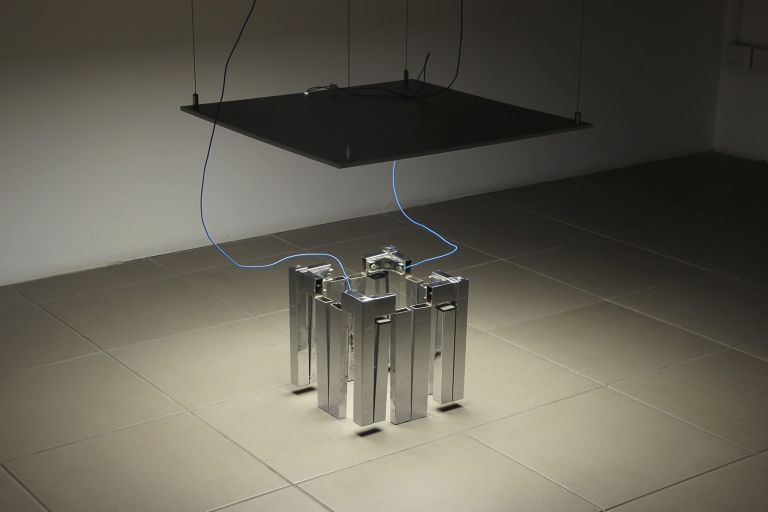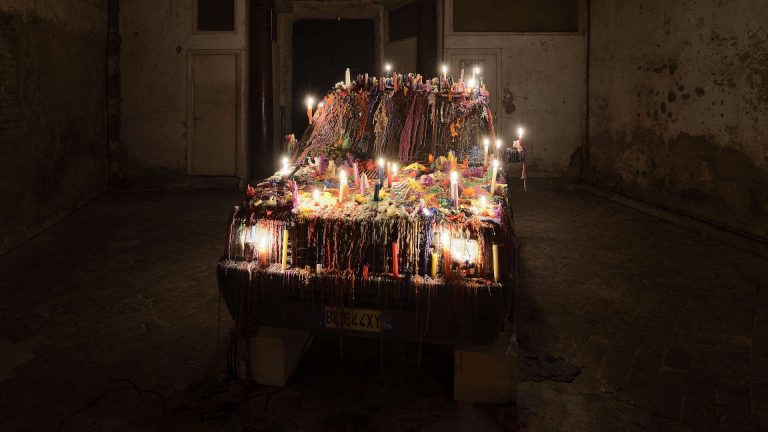Artist: Benjamin Horns
Venue: Federico Vavassori, Milan, Italy
Date: May 25 – June 25, 2016
Photography: all images copyright and courtesy of the artist and Federico Vavassori, Milan
A loft is defined by absence of vertical structural supports piercing the floorplates. It is one of the few domestic architectural typologies which is not defined by use but by a strict structural nomos: its emptiness promises flexibility and its value increases by how much emptiness its engineering virtuosism allows. Most other domestic typologies are described by gendered division of house labour, for example many 18th century french architecture treaties attempted the codification of the bourgeois apartment as a function of the predicted social relations of its inhabitants: served and servant spaces, kitchens, master bedroom, women’s quarters, laundry rooms, distribution, and so on. The indeterminacy of the loft, its purely utilitarian structural definition, seems to allow new domestic relations, a carte blanche to define novel household compounds: a place to live and work, a space to party, a space for polyamorous relationships, a space for single men.
For Aldo Rossi the genealogy of an architectural type is defined by the sum of all its experiences and memories together with its formal rather than material qualities. So if the structural definition is not enough, attempting to follow the evolution of all experiences and memories proves to be a rather imprecise exercise, a necessarily subjective journey. The word loft originates from the germanic luft and the dutch lucht, both meaning air/sky, thus identifying the loft as a space directly under the roof of a building, the closest to the expanse of the atmosphere above, one that, arguably in any building tradition, maximises the space available in the floorplan by virtue of being an interstitial space between the vertical supports of the floor/s below and the structure of the roof above.
One could be tempted to bypass the etymological definition and place the origins of the loft closer to the typology of the Dutch Canal House and the Venetian Palazzo. Both have to negotiate the spatial needs of a trade economy based on water transportation, therefore offer both ample space for storage and equally ample space for reception. The Venetian Palazzo more than the Dutch House has developed a fully formed and consistent typology, evident in the element of the portego. This is an oblong space which connects the water door with the street entrance of a Palazzo; at ground level it is also a space to store goods and boats, while in the floors above it constitutes the longitudinal focus of the house, a large salon for reception, dining and partying. It is only here that we can connect the definition of the modern loft as columnless space with a direct connection to its current use (experiences and memories) and its historical precedent. The portego is an abstract matrix which connects vectors of production and reproduction; in a strikingly similar way the canonical New York (formerly New Amsterdam) Loft is a space appropriated from industrial production to gestate the unholy marriage of life and labour, officiated by the artist.
Where the portego reaches the sky differentiating its functional emptiness on the vertical axis the New York Loft (NYL) establishes a gradient of functions on the horizontal plate: hot and cold zones, work and rest zones, and so on.
From XVIII century Venice to XX century New York City the material and economic conditions have determined the emergence of a precise typology directly influenced by movements of capital, both ending up in longitudinal voids surrounded by exposed bricks and/or stucco, but what is most visible is how the amass of experiences and memories coagulates in real estate formulas: typology is the ultimate expendable currency for an economy driven by experience.
–Alessandro Bava




















